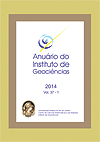Analysis of the thermodynamic structure associated with the development of the storm between 17 and 18 march 2013 in the state of Rio de Janeiro, Brazil
DOI:
https://doi.org/10.11137/2014_1_17_26Abstract
This paper presents an analysis of the thermodynamic structure of the atmosphere with the processes related to a thunderstorm occurred on 17 and 18 March 2013 in the State of Rio de Janeiro. The coupling of a stationary cold front in the Atlantic Ocean with a moisture channel over western central Brazil, resulted in elevated precipitation in the northern part of the Metropolitan Region of Rio de Janeiro (MARJ) and of the surroundings areas (northward highlands). Among the consequences caused by this event are: landslides and urban floods, 34 deaths and material damage. The result was obtained from analysis of radiosonde data, which indicated strong conditional instability, presence of strong advection hot air and wet associate with wind shear in the surface boundary layer, as registered in the International Airport Tom Jobim in late afternoon of March, 17th 2013. The thermodynamic conditions was plenty favorable to the organization and maintenance of deep forced convection, which provided alarming values of precipitation.Downloads
Download data is not yet available.
Downloads
Published
2014-06-01
How to Cite
Sousa, F. B. B. de and Karam, H. A. (2014) “Analysis of the thermodynamic structure associated with the development of the storm between 17 and 18 march 2013 in the state of Rio de Janeiro, Brazil”, Anuário do Instituto de Geociências. Rio de Janeiro, BR, 37(1), pp. 17–26. doi: 10.11137/2014_1_17_26.
Issue
Section
não definida
License
This journal is licensed under a Creative Commons — Attribution 4.0 International — CC BY 4.0, which permits use, distribution and reproduction in any medium, provided the original work is properly cited.















